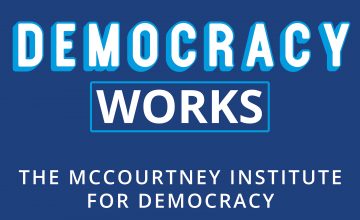Podcast: Play in new window | Download | Embed
Subscribe: Apple Podcasts | Spotify | Email | TuneIn | RSS | More

It’s been 65 years since the Brown v. Board of Education changed public schooling throughout a large portion of the United States. In his opinion, Supreme Court Chief Justice Earl Warren wrote that public education was important to democratic society and the “very foundation of good citizenship.” Integrated schools, the Court argued, would expose children to new cultures and prepare them for an increasingly diverse world.
How do you balance the public good against the inherent desire every parent has to do what’s best for their children? It’s a question that schools across the country are still wrestling with today.

To help us understand the history of integration and the Brown decision’s impacts on public policy, we’re talking this week with two experts at Penn State. Crystal Sanders is an associate professor of history and African American studies and director of the Africana Research Center. She’s an expert on 20th century African American history. Erica Frankenberg is a professor of education and demography and director of the Center for Education and Civil Rights. She is an an expert on the connection between school segregation and public policy.
Crystal and Erica co-chaired a conference at Penn State on the 65th anniversary of the Brown decision.
Additional Information
Brown v. Board of Education opinion
Our episode on school boards with Robert Asen of the University of Wisconsin-Madison
A note to our listeners in the New York City area: Jenna Spinelle will be participating in a panel called “Podcasts to the Rescue! An Emerging Medium for Learning About Civics, Government, and the Social Contract” on Thursday, May 30 at the Metropolitan New York Library Council. The event is free and open to the public. We would love to meet you!
Discussion/Reflection Questions
- What is the relationship between school segregation and democracy?
- Did you attend an integrated or a segregated school? How did that impact you once you finished school?
- How should the education system change to become more integrated?
- How is the re-segregation that Erica and Crystal affecting students in the U.S.? How is it impacting the country more broadly?
Interview Highlights
[5:52] What was the political climate when the decision of Brown v. Board of Education was made
There were many people on the ground; black teachers, black principals, black parents who had been organizing for generations for quality educational opportunities for their students. Decades prior March 1954, black parents were mobilizing to ensure that their students had the resources to ensure that their students to get to school.
[7:43] How was the Brown decision received?
There was a massive resistance at the beginning. The reason because Dwight Eisenhower in 1957 for sending troops to Little Rock was essentially because the rest of the world was watching and laughing at us. We see white parents taking their kids out of public schools, we see entire school system shutting down, as was the case in Prince, Edward County, Virginia. It takes a very long time before we even began to see real implementation. We are seeing now a widespread re-segregation across the country.
[9:37] What are some of the factors that are causing re-segregation?
One of the things that most people might not be aware of is that more than 25 states allow communities to secede from a school system and create their own new school system. Across the country, but especially in wealthy suburbs and Southern states, we see wealthy white communities pull out from school systems and create their own new school system that allows them to maintain racial segregation.
[12:24] A lot of the conversation around school segregation focuses on the South. What was going on in other parts of the country?
It’s important to think about how School desegregation look different in the South versus the North. In northern states there were a lot of ways in which structures were used to create segregated schools. There was the first two decades after the Brown decision in which there were a lot of questions legally as to how Brown would apply outside of the South. When we think of re-segregation today, whether we’re talking about the north or the south, we have to look at housing patterns. We have to look at the lack of affordable housing and the ways in which we still have very weak fair housing laws, and that has been detrimental to ensuring that our public schools are as diverse and inclusive as they can and should be.
[15:56] What’s the relationship between school integration and the public good?
I believe that most Americans still believe that public education is a public good. I don’t believe that most Americans believe integration is a public good. Those are two separate things. There’s still some investment in public education, but there is no investment in integration as a public good.
[17:59] What do we know about the outcomes of integrated schools?
There are social and psychological benefits of integrated schools for all students. Students from integrated schools are less likely to have racial stereotypes and prejudice formation. There are important benefits in terms of being more likely to live and work in diverse spaces as an adult. Some research even finds you’re more likely live in more integrated neighborhoods.
[23:11] Are there particular cities or communities that that have been particularly successful at integration?
No district is perfect, but some communities are intriguing. Jefferson County, Kentucky had court-ordered desegregation in the 1970’s, and in 2000 the court said they had met the requirements. The Wake County school system in North Carolina has done a phenomenal job by ensuring that they have diverse schools across the district. They created a plan that used race to ensure that all of the high schools in the district had proportional levels of different populations.





